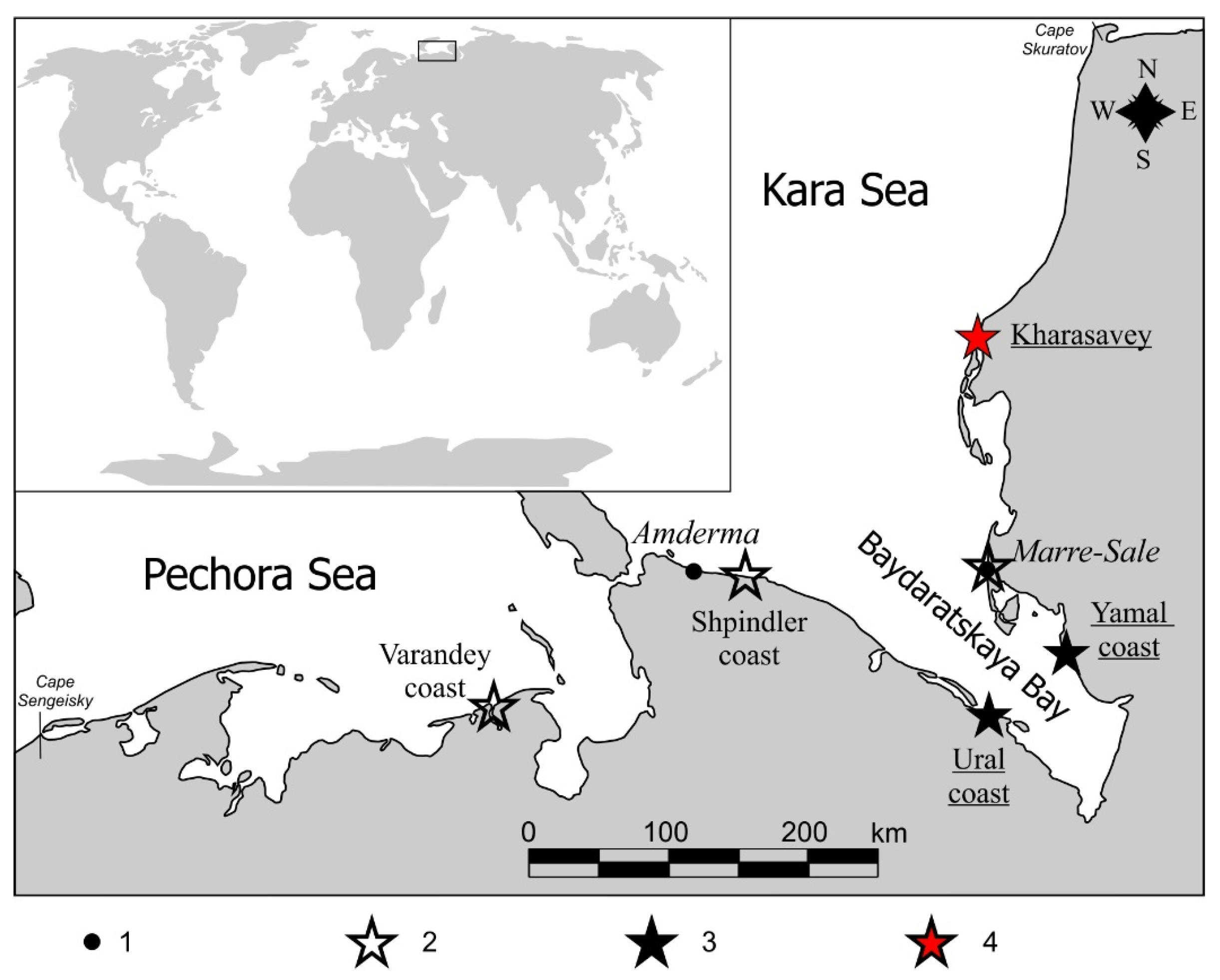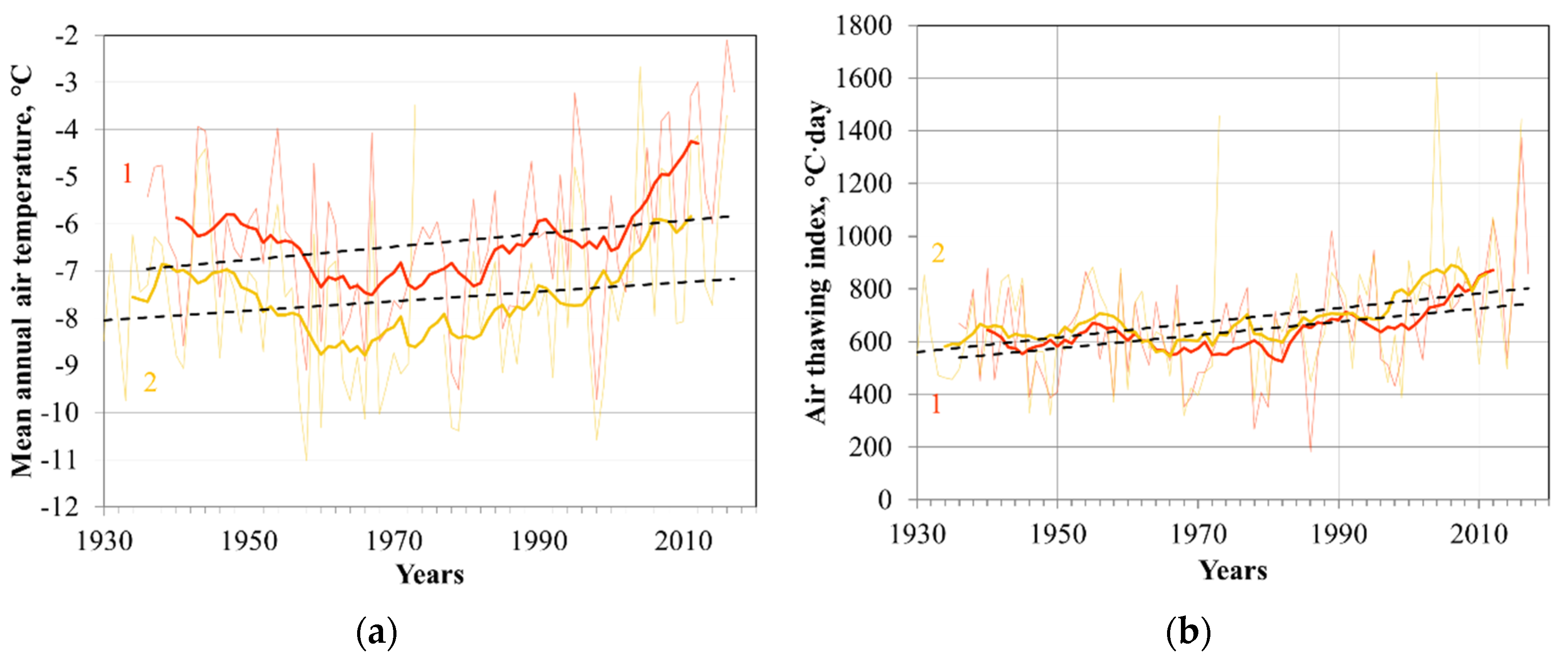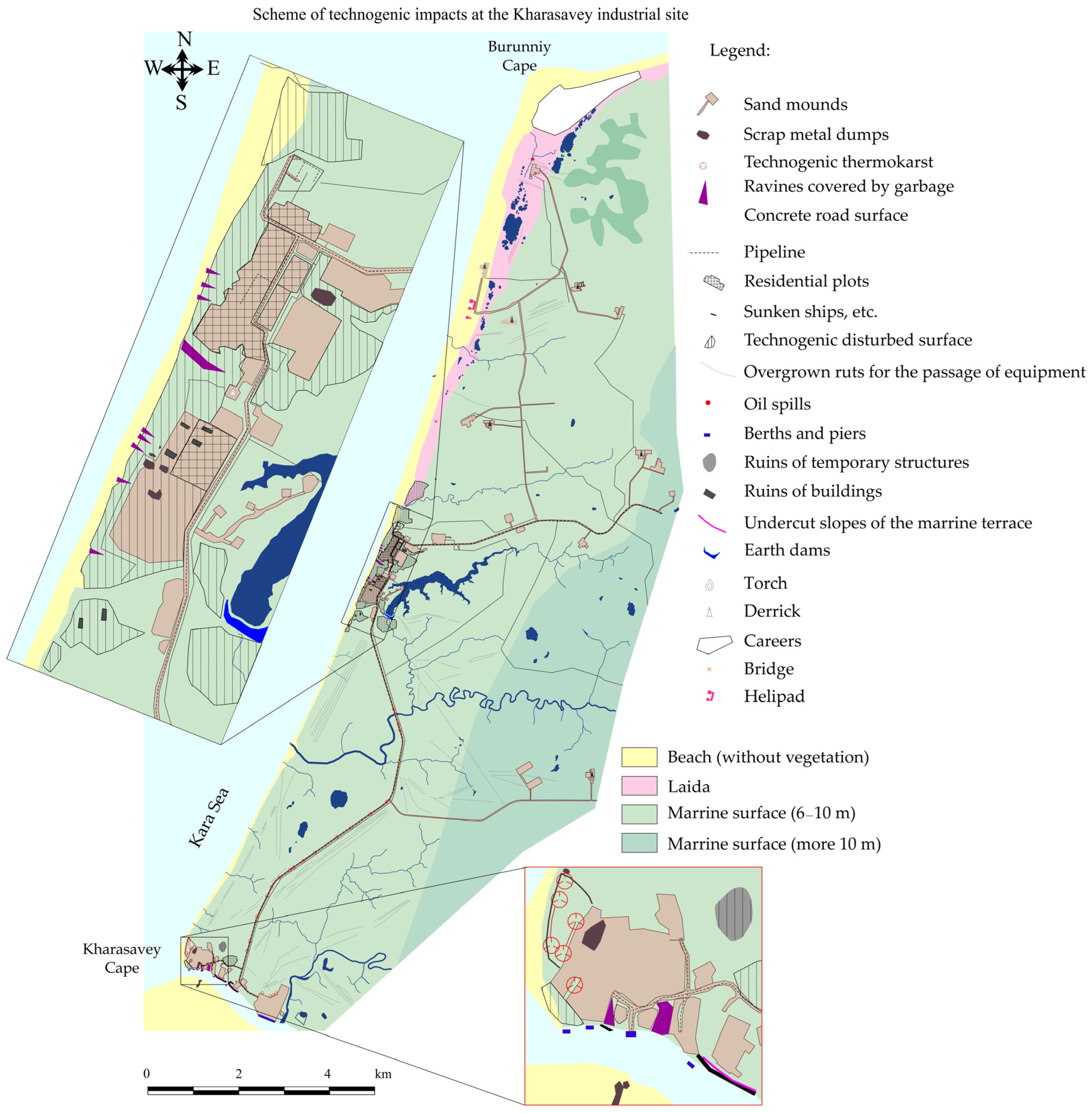Sea Coast of the Western Part of the Russian Arctic under Climate Change: Dynamics, Technogenic Influence and Potential Economic Damage
Abstract
1. Introduction
2. Study Area
3. Materials and Methods
3.1. Estimation of the Coastal Dynamics
3.2. Coastal Dynamics Prediction
3.3. The Technogenic Impacts at the Kharasavey Coast
3.4. Assessment of the Damaged Cost
4. Results and Discussion
4.1. Coastal Erosion on Key Sites
4.2. Prediction of Coastal Erosion under Climate Changes
4.3. Technogenic Disturbances in the Kharasavey Coast
4.4. Potential Economic Damage
5. Conclusions
Author Contributions
Funding
Data Availability Statement
Conflicts of Interest
References
- Zakharov, V.F. Arctic Ice and Modern Natural Processes; Gidrometeoizdat: Leningrad, Russia, 1981; 136p. (In Russian) [Google Scholar]
- Alekseev, G.V. Research on climate change in the Arctic in the XX century. Tr. AANII 2003, 446, 6–21. (In Russian) [Google Scholar]
- Shabanova, N.; Ogorodov, S.; Shabanov, P.; Baranskaya, A. Hydrometeorological forcing of western russian arctic coastal dynamics: XX-century history and current state. GES 2018, 1, 113–129. [Google Scholar] [CrossRef]
- Ogorodov, S.A.; Shabanova, N.N.; Kessel, A.S.; Baranskaya, A.V.; Razumov, S.O. Changes of the hydrometeorological potential of thermoabrasion on the Russian Arctic sea coasts. In Vestnik Moskovskogo universiteta. Seriya 5, Geografiya; Moscow State University: Moscow, Russia, 2022; pp. 26–42. (In Russian) [Google Scholar]
- Brouchkov, A.V. Frozen saline soils of the Arctic coast: Their distribution and engineering properties. In Proceedings of the 8th International Conference on Permafrost, Zürich, Switzerland, 21–25 July 2003; pp. 95–100. [Google Scholar]
- Ogorodov, S.A.; Baranskaya, A.V.; Belova, N.G.; Kamalov, A.M.; Kuznetsov, D.E.; Overduin, P.; Shabanova, N.N.; Vergun, A.P. Coastal Dynamics of the Pechora and Kara Seas Under Changing Climatic Conditions and Human Disturbances. GES 2016, 3, 53–73. [Google Scholar] [CrossRef] [PubMed]
- Novikova, A.; Belova, N.; Baranskaya, A.; Aleksyutina, D.; Maslakov, A.; Zelenin, E.; Shabanova, N.; Ogorodov, S. Dynamics of Permafrost Coasts of Baydaratskaya Bay (Kara Sea) Based on Multi-Temporal Remote Sensing Data. Remote Sens. 2018, 10, 1481. [Google Scholar] [CrossRef]
- Belova, N.G.; Shabanova, N.N.; Ogorodov, S.A.; Kamalov, A.M.; Kuznetsov, D.E.; Baranskaya, A.V.; Novikova, A.V. Erosion of permafrost coasts of Kara Sea near Kharasavey Cape, Western Yamal. Kriosf. Zemli 2017, 6, 85–97. [Google Scholar] [CrossRef]
- Vasiliev, A.; Kanevskiy, M.; Cherkashov, G.; Vanshtein, B. Coastal dynamics at the Barents and Kara Sea key sites. Geo-Mar. Lett. 2005, 25, 110–120. [Google Scholar] [CrossRef]
- Manson, G.K.; Solomon, S.M. Past and Future Forcing of the Beaufort Sea Coastal Change. Atmos -Ocean. 2007, 45, 107–122. [Google Scholar] [CrossRef]
- Henqutte, A.; Desrosiers, M.; Hill, P.R.; Forbes, D.L. The influence of coastal morphology on shoreface sediment transport under storm-combined flows, Canadian Beaufort Sea. J. Coast. Res. 2001, 17, 507–516. [Google Scholar]
- Baird & Associates Staff. Thermal-Mechanical Mode for Erosion on Arctic Coasts. In Final Report prepared for Geological Survey of Canada; Bedford Institute of Oceanography: Oakville, ON, Canada, 1995; 128p. [Google Scholar]
- Kobayashi, N. Formation of thermoerosional niches into frozen bluffs due to storm surges on the Beaufort Sea Coast. J. Geophys. Res. 1985, 90, 11983–11988. [Google Scholar] [CrossRef]
- Implementation of Cost Benefit Analysis of Coastal Risk Management Prevention Measures against Natural Hazards. Available online: https://civil-protection-humanitarian-aid.ec.europa.eu/system/files/2017-11/ecoshaz_guidelines_1.pdf (accessed on 10 May 2023).
- Penning-Rowsell, E.C.; Priest, S.; Parker, D.; Morris, J.; Tunstall, S.; Viavattene, C.; Chatterton, J.; Owen, D. Flood and Coastal Erosion Risk Management: A Manual for Economic Appraisal; Routledge: London, UK; New York, NY, USA, 2013. [Google Scholar]
- Flood and Coastal Erosion Risk Management and the Local Economy. Available online: https://assets.publishing.service.gov.uk/media/6033e1838fa8f54331b08155/_FD2662_full_toolkit.pdf (accessed on 10 May 2023).
- Chang, J.I.; Yoon, S. The economic benefit of coastal erosion control in Korea. J. Coast. Res. 2016, 75, 1317–1321. [Google Scholar] [CrossRef]
- Landry, C.E. Coastal erosion as a natural resource management problem: An economic perspective. Coast. Manag. 2011, 3, 259–281. [Google Scholar] [CrossRef]
- Repkina, T.Y.; Lugovoy, N.N.; Romanenko, F.A.; Lukyanova, S.A. Sea coasts of the Russian Arctic: Types and chronology of human-induced changes. Vestn. Mosk. Universiteta. Seriya 5 Geogr. 2020, 6, 10–20. (In Russian) [Google Scholar]
- Khavanskiy, A.D.; Khoroshev, O.A.; Merinova, Y.Y. Assessment of the material damage of abrasive and landslide processes effect in municipalities in the coastal zone of the Azov Sea. Sci. South Russ. 2021, 2, 74–82. (In Russian) [Google Scholar]
- Arctic Monitoring and Assessment Programme (AMAP). Snow, Water, Ice and Permafrost in the Arctic (SWIPA); Oslo, Norway, 2017; p. 269. Available online: https://www.amap.no/documents/doc/snow-water-ice-and-permafrost-in-the-arctic-swipa-2017/1610 (accessed on 10 May 2023).
- Badina, S.V.; Pankratov, A.A. The value of buildings and structures for permafrost damage prediction: The case of eastern Russian Arctic. GES 2021, 4, 83–92. [Google Scholar] [CrossRef]
- Pilyasov, A.N.; Putilova, E.S. New projects for the development of Russian Arctic: Space matters. Arct. North 2020, 38, 20–42. [Google Scholar]
- Gusev, E.A.; Rekant, P.V.; Anokhin, V.M.; Bolshiyanov, D.Y.; Zarkhidze, D.V.; Shkarubo, S.I.; Sharin, V.V.; Dymov, V.A. Comparison of late Quaternary conditions in the western and eastern sectors of the Russian Arctic. In Abstracts of the International Workshop “The Problem of Correlation of Pleistocene Events in the Russian North”, 4–6 December 2006, St. Petersburg, Russia; VSEGEI Publisher: St. Petersburg, Russia, 2006; p. 37. [Google Scholar]
- Luk’yanova, S.A.; Saf’yanov, G.A.; Solov’eva, G.D.; Shipilova, L.M. Types of Arctic coasts of Russia. Oceanology 2008, 2, 268–274. (In Russian) [Google Scholar] [CrossRef]
- Kizyakov, A.I.; Ermolov, A.A. Morphodynamic segmentation of the Kara Sea coast. In Arctic Coasts: The Path to Sustainability; Proceedings of the XXVII International Coastal Conference, Murmansk, Russia, 24–29 September 2018; Murmansk Arctic State University: Murmansk, Russia, 2018; pp. 92–95. ISBN 978-5-4222-0367-3. (In Russian) [Google Scholar]
- Yershov, E.D. (Ed.) Geocryologic Map of the USSR. Scale 1:2, 500,000 Million; State Cartographic Factory: Vinnytsia, Ukraine, 1991. (In Russian) [Google Scholar]
- Ogorodov, S.A. Barents Sea Coasts. GES 2011, 4, 34–51. [Google Scholar] [CrossRef]
- Kizyakov, A.I.; Leibman, M.O.; Perednya, D.D. Destructive relief-forming processes at the coasts of the Arctic plains with tabular ground ice. Kriosf. Zemli 2006, 2, 79–89. (In Russian) [Google Scholar]
- Aleksyutina, D.; Ogorodov, S.; Shilova, O.S. Simulation of coastal dynamics at the Kara Sea. Glob. Coast. Issues 2020 J. Coast. Res. 2020, 95, 330–335. [Google Scholar] [CrossRef]
- Guégan, E.; Sinitsyn, A.; Kokin, O.; Ogorodov, S. Coastal Geomorphology and Ground Thermal Regime of the Varandey Area. J. Coast. Res. 2016, 321, 1025–1031. [Google Scholar] [CrossRef]
- Kizyakov, A.I. The dynamics of thermodenudation processes at the Yugorsky Peninsula coast. Kriosf. Zemli 2005, 9, 63–68. (In Russian) [Google Scholar]
- Aleksyutina, D.; Belova, N.; Baranskaya, A.; Ogorodov, S. Morphological and permafrost factors of coastal dynamics at Kara Sea 14th MEDCOAST Congress on Coastal and Marine Sciences, Engineering, Management and Conservation. Medcoast 2019, 2, 639–649. [Google Scholar]
- Aleksyutina, D.; Motenko, R.; Belova, N.; Shilova, O. Properties of frozen and thawed soils, baydaratskaya bay coast, Kara Sea: Variability and trends. In Proceedings of the International Multidisciplinary Scientific GeoConference Surveying Geology and Mining Ecology Management SGEM, Albena, Bulgaria, 30 June–9 July 2018; STEF92 Technology Ltd.: Sofia, Bulgaria, 2018; Volume 18, pp. 397–404. [Google Scholar] [CrossRef]
- Ogorodov, S.A.; Aleksyutina, D.M.; Baranskaya, A.V.; Shabanova, N.N.; Shilova, O.S. Coastal erosion of the Russian Arctic: An overview. Glob. Coast. Issues 2020 J. Coast. Res. 2020, 95, 599–604. [Google Scholar] [CrossRef]
- Sinitsyn, A.; Guegan, E.; Kokin, O.; Vergun, A.; Udalov, L.; Ogorodov, S. Investigations of coastal erosion processes in Varandey area, Barents Sea. In Proceedings of the SPE Conference, Arctic and Extreme Environments (Moscow, Russia, Society of Petroleum Engineers), Moscow, Russia, 15–17 October 2013. [Google Scholar] [CrossRef]
- Kritsuk, L.N.; Dubrovin, V.A.; Yastreba, N.V. Some results of integrated study of the Kara coastal dynamics in the Marre-Sale meteorological station area, with the use of GIS technologies. Kriosf. Zemli 2014, 4, 59–69. [Google Scholar]
- Aleksyutina, D.; Novikova, A.; Baranskaya, A.; Shilova, O.; Ogorodov, S. Using multi-temporal aerial and space imagery for coastal dynamics investigations at Kara and Pechora Seas, Russian Arctic. In Proceedings of the International Multidisciplinary Scientific GeoConference Surveying Geology and Mining Ecology Management SGEM, Albena, Bulgaria, 30 June–9 July 2018; STEF92 Technology Ltd.: Sofia, Bulgaria, 2018; Volume 18, pp. 265–272. [Google Scholar] [CrossRef]
- Baranskaya, A.; Novikova, A.; Shabanova, N.; Belova, N.; Maznev, S.; Ogorodov, S.; Jones, B.M. The Role of Thermal Denudation in Erosion of Ice-Rich Permafrost Coasts in an Enclosed Bay (Gulf of Kruzenstern, Western Yamal, Russia). Front. Earth Sci. 2021, 8, 566227. [Google Scholar] [CrossRef]
- Bulygina, O.N.; Razuvayev, V.N.; Trofimenko, L.T.; Shvets, N.V. Description of Daily Air Temperature and Precipitation Data Set from Russian Meteorological Stations and from Some Meteorogical Stations Over the Former USSR Territory (TTTR). 2014. Available online: http://meteo.ru/english/climate/d_temp.php (accessed on 10 January 2019).
- Ivanova, N.V.; Rivkin, F.M.; Vlasova, U.V. The permafrost structure and formation regularities on the Pechora Sea coast. Kriosf. Zemli 2008, 2, 19–24. [Google Scholar]
- Lantuit, H.; Overduin, P.P.; Wetterich, S. Recent Progress Regarding Permafrost Coasts. Permafr. Periglac. Process. 2013, 24, 120–130. [Google Scholar] [CrossRef]
- Atlas of Abrasion and Ice-Exaration Hazards in the Coastal-Shelf Zone of the Russian Arctic. Electronic Edition. Version 12.2020. Moscow, Research Laboratory of Geoecology of the North, Geographic Faculty of Moscow State University. 2020. Available online: http://www.geogr.msu.ru/structure/labs/geos/links/Atlas2020/Atlas12.2020-%D1%81%D0%B6%D0%B0%D1%82%D1%8B%D0%B9.pdf (accessed on 15 March 2023).
- Irrgang, A.M.; Bendixen, M.; Farquharson, L.M.; Baranskaya, A.V.; Erikson, L.H.; Gibbs, A.E.; Ogorodov, S.A.; Overduin, P.P.; Lantuit, H.; Grigoriev, M.N.; et al. Drivers, dynamics and impacts of changing Arctic coasts. Nat. Rev. Earth Environ. 2022, 3, 39–54. [Google Scholar] [CrossRef]
- Kislov, A.V.; Alyautdinov, A.R.; Baranskaya, A.V.; Belova, N.G.; Bogatova, D.M.; Vikulina, M.A.; Zheleznova, I.V.; Surkova, G.V.; Kraev, G.N. Forecast of climate change and the intensity of exogenous processes in the Yamalo-Nenets Autonomous Okrug. Rep. Russ. Acad. Sci. Earth Sci. 2023, 2, 233–240. (In Russian) [Google Scholar]
- Kislov, A.; Alyautdinov, A.; Baranskaya, A.; Belova, N.; Bogatova, D.; Vikulina, M.; Zheleznova, I.; Surlova, G. A spatially detailed projection of environmental conditions in the Arctic initiated by climate change. Atmosphere, 2023; in press. [Google Scholar]
- Shabanov, P.A.; Shabanova, N.N. Ice-free period detection method in the Arctic coastal zone. Russ. J. Earth Sci. 2020, 20, ES6016. [Google Scholar] [CrossRef]
- Ogorodov, S.A. Effects of Changing Climate and Sea Ice Extent on Dynamics of Russian Arctic. Probl. Arct. Antarct. 2008, 1, 123–128. (In Russian) [Google Scholar]
- Ogorodov, S.A. Morpholithodynamics of the coastal zone of the Varandey region of the Pechora Sea in the conditions of anthropogenic pressure. Geoecology Eng. Geol. Hydrogeol. Geocryol. 2004, 3, 1–6. (In Russian) [Google Scholar]
- Kopa-Ovdienko, N.V.; Ogorodov, S.A. Peculiarities of the dynamics of thermoabrasive coasts of the Baydaratskaya Bay of the Kara Sea at the present stage. Geomorfologiya 2016, 3, 12–21. [Google Scholar]
- Bogatova, D.M.; Shabanova, N.N.; Ogorodov, S.A. Contribution of the thermak and wave energy drivers to permafrost coastal dynamics in the Kara Sea. Nat. Tech. Sci. 2021, 9, 74–81. (In Russian) [Google Scholar]
- Rosreestr. Available online: https://pkk.rosreestr.ru/ (accessed on 1 May 2023).
- Berdnikova, V.N. Cadastral and Market Value: The Similarities and Differences. Bulletin of Chelyabinsk State University. Econ. Sci. 2019, 9, 210–216. (In Russian) [Google Scholar]
- Kotlyarov, M.A.; Tatarkin, D.A.; Animitsa, P.E. The relationship between the market and cadastral value of real estate for tax purposes. Econ. Taxes Law 2012, 6, 25–30. [Google Scholar]
- Frolov, A. Expensive gas pipelines. Corp. Mag. GAZPROM 2012, 3, 24–26. (In Russian). Available online: https://www.gazprom.ru/press/journal/ (accessed on 10 May 2023).
- Ogorodov, S.A. Human impacts on coastal stability in the Pechora Sea. Geo-Mar. Lett. 2005, 2, 190–195. [Google Scholar] [CrossRef]
- Novikov, V.N.; Fedorova, E.V. Destruction of coasts in the southeastern part of the Barents Sea. In Bulletin of Moscow State University, Series 5 Geography; Moscow State University: Moscow, Russia, 1989; pp. 64–68. (In Russian) [Google Scholar]
- Sinitsyn, A.O.; Guegan, E.; Shabanova, N.; Kokin, O.; Ogorodov, S. Fifty four years of coastal erosion and hydrometeorological parameters in the Varandey region, Barents Sea. Coast. Eng. 2020, 157, 103610. [Google Scholar] [CrossRef]
- Sovershaev, V.A.; Kamalov, A.M. Stability of seashores in permafrost. In Geoecology of the North: An Introduction to Geocryoecology; MGU publisher: Moscow, Russia, 1992; pp. 95–103. [Google Scholar]
- Romanenko, F.A. Intensity of geomorphological processes on the islands and coasts of the Kara and Laptev seas (based on observations from polar stations). Geomorphology 2008, 1, 56–64. (In Russian) [Google Scholar]
- Vasiliev, A.A.; Streletskaya, I.D.; Cherkashev, G.A.; Vanshtein, B.G. The Kara Sea coastal dynamics. Kriosf. Zemli 2006, 2, 56–67. (In Russian) [Google Scholar]
- Yuryev, I.V. Problems of operation of gas facilities in the coastal zone of Western Yamal. Kriosf. Zemli 2009, 13, 46–54. [Google Scholar]
- Belova, N.G.; Shabanova, N.N.; Ogorodov, S.A.; Baranskaya, A.V.; Novilova, A.V. Coastal Erosion at Kharasavey Gas Condensate Field, Western Yamal Peninsula. In Proceedings of the SPE Russian Petroleum Technology Conference 2018 (Moscow, Russia), Moscow, Russia, 15–17 October 2018. [Google Scholar] [CrossRef]






| No. | Midpoint Coordinates of the Plot | Average Coast Retreat Rate within the Boundaries of the Plot, m/year | Section Length, m | Cadastral Value of 1 sq. m within the Boundaries of the Plot | Land Category | Permitted Use | Presence of Man-Made Objects |
|---|---|---|---|---|---|---|---|
| 1 | 68.7692; 57.7296 | 1.8 | 29,000 | 103.6 | Agricultural land | Subsoil use | - |
| 2 | 68.8362; 58.1405 | 3.2 | 8000 | 25,600 | Lands of industry, energy, transport, communications, radio broadcasting, television, informatics, land for space activities, defense, security and other special-purpose lands | Subsoil use; placement of capital construction facilities; for storage of materials; under the Varandey airfield site, etc. | + |
| 3 | 68.8530; 66.8986 | 0.9 | 1800 | 1.8 | Lands of industry, energy, transport, communications, radio broadcasting, television, informatics, land for space activities, defense, security and other special-purpose lands | Pipeline transport | + |
| 4 | 69.3438; 64.7869 | 0.35 | 35,067 | 0.002 | Agricultural land | For reindeer breeding | - |
| Study Are | Coefficient of Correlation between Retreat Rate and Various Factors | ||
|---|---|---|---|
| Thermal | Wind-Wave | Total Effect | |
| Varandey 1 | N/D | 0.8 | 0.6 |
| Shpindler 2 | 0.941 | −0.346 | 0.866 |
| Ural coast 2 | 0.870 | 0.644 | 0.890 |
| Yamal coast 2 | 0.419 | 0.448 | 0.440 |
| Marre-Sale 2 | 0.751 | 0.217 | 0.603 |
| Kharasavey 2 | 0.983 | 0.973 | 0.980 |
| Study Area | Factor Weight, % | |
|---|---|---|
| Thermal | Wind-Wave | |
| Varandey | N/D | N/D |
| Shpindler 1 | 64 | 36 |
| Ural coast 1 | 56 | 44 |
| Yamal coast 1 | 21 | 79 |
| Marre-Sale 1 | 82 | 18 |
| Kharasavey 1 | 77 | 23 |
| Climate Change | Territory | Natural Territory | Territory with Infrastructure | ||
|---|---|---|---|---|---|
| From | To | From | To | ||
| Current trend [4] | All study area | $598,535 | $1,453,618 | $2,650,655 | $7,744,406 |
| Zapolyarny District NAO | $572,713 | $1,387,989 | $2,893,896 | $7,517,564 | |
| Priuralsky District YaNAO | $9530 | $34,851 | $96,596 | $191,568 | |
| Yamalsky District YaNAO | $13,191 | $30,778 | $16,504 | $35,274 | |
| SSP5-8.5 [43] | All study area | $2,378,515 | $4,826,750 | $9,863,941 | $15,609,810 |
| Zapolyarny District NAO | $2,280,162 | $4,663,939 | $9,646,498 | $15,233,096 | |
| Priuralsky District YaNAO | $35,512 | $52,888 | $148,697 | $261,845 | |
| Yamalsky District YaNAO | $52,763 | $109,922 | $57,622 | $116,880 | |
Disclaimer/Publisher’s Note: The statements, opinions and data contained in all publications are solely those of the individual author(s) and contributor(s) and not of MDPI and/or the editor(s). MDPI and/or the editor(s) disclaim responsibility for any injury to people or property resulting from any ideas, methods, instructions or products referred to in the content. |
© 2023 by the authors. Licensee MDPI, Basel, Switzerland. This article is an open access article distributed under the terms and conditions of the Creative Commons Attribution (CC BY) license (https://creativecommons.org/licenses/by/4.0/).
Share and Cite
Ogorodov, S.; Badina, S.; Bogatova, D. Sea Coast of the Western Part of the Russian Arctic under Climate Change: Dynamics, Technogenic Influence and Potential Economic Damage. Climate 2023, 11, 143. https://doi.org/10.3390/cli11070143
Ogorodov S, Badina S, Bogatova D. Sea Coast of the Western Part of the Russian Arctic under Climate Change: Dynamics, Technogenic Influence and Potential Economic Damage. Climate. 2023; 11(7):143. https://doi.org/10.3390/cli11070143
Chicago/Turabian StyleOgorodov, Stanislav, Svetlana Badina, and Daria Bogatova. 2023. "Sea Coast of the Western Part of the Russian Arctic under Climate Change: Dynamics, Technogenic Influence and Potential Economic Damage" Climate 11, no. 7: 143. https://doi.org/10.3390/cli11070143
APA StyleOgorodov, S., Badina, S., & Bogatova, D. (2023). Sea Coast of the Western Part of the Russian Arctic under Climate Change: Dynamics, Technogenic Influence and Potential Economic Damage. Climate, 11(7), 143. https://doi.org/10.3390/cli11070143







